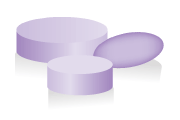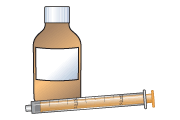Dexamethasone for croup
This leaflet is for parents and carers about how to use this medicine in children. Our information may differ from that provided by the manufacturers, because their information usually relates to adults. Read this leaflet carefully. Keep it somewhere safe so that you can read it again.
Name of medicine
Dexamethasone
Brand name: Dexsol®, Martapan®
This leaflet is about the use of dexamethasone for croup.
Why is it important for my child to take dexamethasone?
Croup is caused by a virus. Usually it is mild, and children get well without needing any treatment. Sometimes, however, a child has difficulty breathing.
Dexamethasone will reduce inflammation (swelling) and help them to breathe more easily. Often only a single dose is needed to help their breathing but some children may need more than one dose.
What is dexamethasone available as?
Tablets: 500 micrograms and 2 mg; these tablets contain lactose
Liquid medicine: 2 mg or 10 mg in 5 mL
When should I give dexamethasone
Usually, only a single dose of dexamethasone is needed – the doctor will give this to your child straight away.
The doctor may give you another dose of dexamethasone to take home with you, in case your child continues to have problems breathing. Give the second dose usually 12 hours after the first dose if your child is awake, is continuing to have problems breathing and is distressed.
How much should I give?
Your doctor will work out the amount of dexamethasone (the dose) that is right for your child. The dose will be shown on the medicine label.
It is important that you follow your doctor’s instructions about how much to give.
How should I give dexamethasone?

Tablets
- Tablets should be swallowed with a glass of water, squash or juice. Your child should not chew the tablets.
- You can crush the tablet and mix it with a small amount of soft food such as yogurt, honey, or mashed potato. Make sure your child swallows it straight away, without chewing.

Liquid medicine
Measure out the right amount using a medicine spoon or oral syringe. You can get these from your pharmacist. Do not use a kitchen teaspoon as it will not give the right amount.
When should the medicine start working?
The medicine will start to work within an hour but it may take up to 4 hours for your child’s breathing to return to normal. During this time, do what you can to keep your child calm – they may or may not want to be cuddled; they may find it easier to breathe sitting up rather than laying down; it may help to distract them by playing music, reading stories or watching television. It is important to avoid distress, as this will make their breathing worse.
If your child’s breathing gets worse, even after taking the medicine, you should take your child back to the doctor.
What if my child is sick (vomits)?
If your child is sick less than 30 minutes after having a dose of dexamethasone, give them the same dose again.
If your child is sick more than 30 minutes after having a dose of dexamethasone, you do not need to give them another dose.
What if I give too much?
You are unlikely to do harm with just two doses of dexamethasone. If you concerned that you may have given too much, contact your doctor or local NHS services (111 in England and Scotland; 0845 4647 in Wales). Have the medicine or packaging with you if you telephone for advice.
Are there any possible side effects?
We use medicines to make our children better, but sometimes they have other effects that we don’t want (side-effects). It is unlikely that your child will have any side-effects after only one or two doses of dexamethasone for croup.
They may feel sick or be sick (vomit), get hiccups, or have stomach pain.
There may, sometimes, be other side-effects that are not listed above. If you notice anything unusual and are concerned, contact your doctor. You can report any suspected side-effects to a UK safety scheme at http://www.mhra.gov.uk/yellowcard.
Can other medicines be given at the same time as dexamethasone?
- You can give your child medicines that contain paracetamol or ibuprofen, unless your doctor has told you not to.
Is there anything else I need to know about this medicine?
If your doctor provided a second dose and you did not use it, return the medicine to a pharmacy so it can be safely disposed. Do not keep it in case your child gets croup again.
Only give dexamethasone to your child. Never give it to anyone else, even if their condition appears to be the same, as this could do harm.
If you think someone else may have taken the medicine by accident, contact your doctor
Where should I keep this medicine?
- Keep the medicine in a cupboard, away from heat and direct sunlight. It does not need to be kept in the fridge. Do not store above 25°C.
- Make sure that children cannot see or reach the medicine.
- Keep the medicine in the container it came in.
Who to contact for more information?
Your child’s doctor, pharmacist or nurse will be able to give you more information about dexamethasone and about other medicines used to treat croup.
England: NHS 111
Tel 111
www.nhs.ukScotland: NHS 24
Tel 111
www.nhs24.scotNorthern Ireland: NI Direct
Wales: NHS 111 Wales
Tel 111
www.111.wales.nhs.ukCopyright disclaimer
Version [2]. © NPPG, RCPCH and WellChild, all rights reserved. Review by July 2017.
The primary source for the information in this leaflet is the British National Formulary for Children. For details on any other sources used for this leaflet, please contact us through our website, www.medicinesforchildren.org.uk.
We take great care to make sure that the information in this leaflet is correct and up-to-date. However, medicines can be used in different ways for different patients. It is important that you ask the advice of your doctor or pharmacist if you are not sure about something. This leaflet is about the use of these medicines in the UK, and may not apply to other countries. The Royal College of Paediatrics and Child Health (RCPCH), the Neonatal and Paediatric Pharmacists Group (NPPG), WellChild and the contributors and editors cannot be held responsible for the accuracy of information, omissions of information, or any actions that may be taken as a consequence of reading this leaflet.
